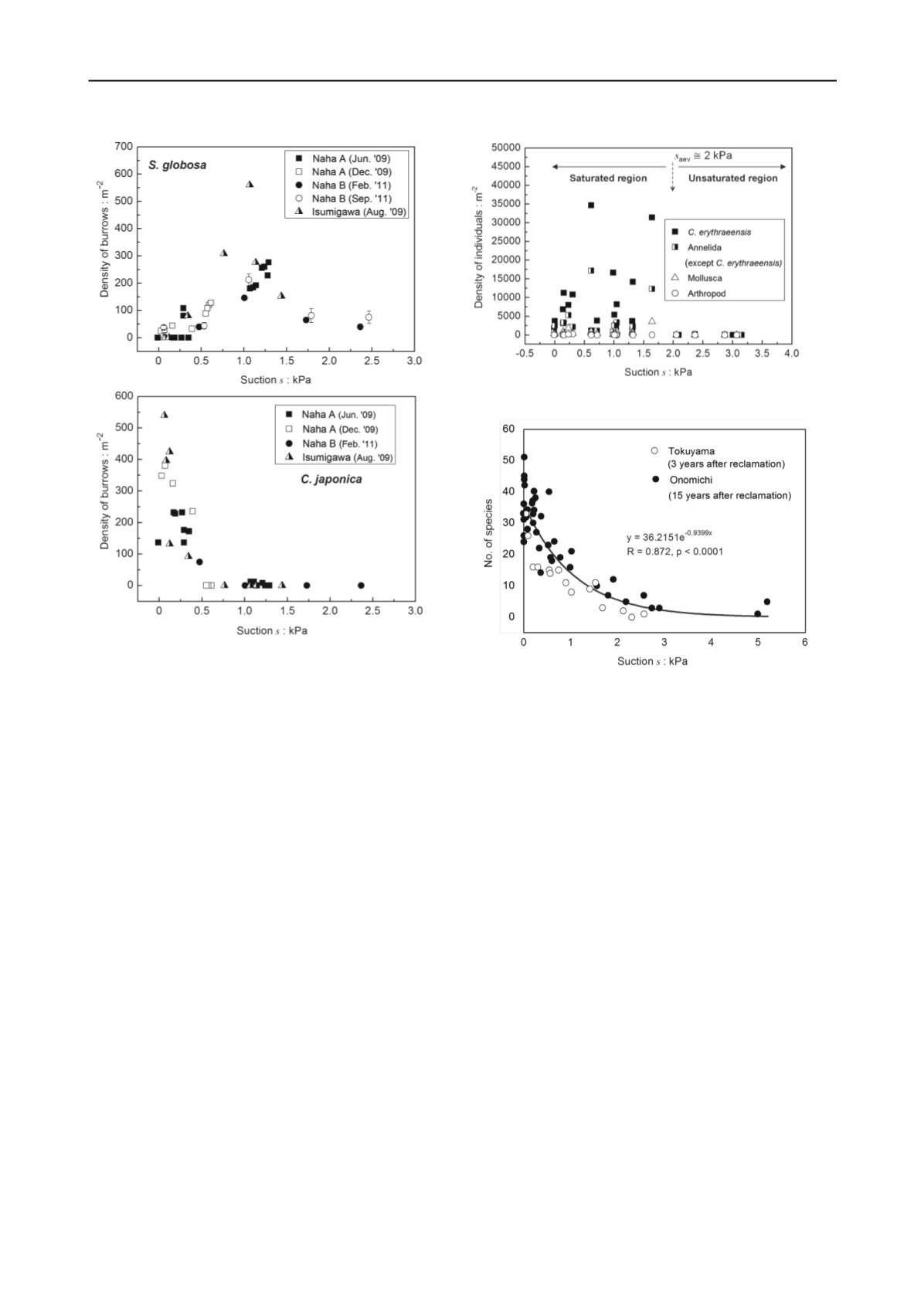
3072
Proceedings of the 18
th
International Conference on Soil Mechanics and Geotechnical Engineering, Paris 2013
Proceedings of the 18
th
International Conference on Soil Mechanics and Geotechnical Engineering, Paris 2013
Figure 5. Relationships between suction and individual densities of the
sand bubble crab and the decapod crustacean at three intertidal flats
consistent with the ecohabitat chart showing that the burrowing
capability of
C. erythraeensis
was markedly higher than other
species and thereby exhibited the characteristics as the initial
species inhabiting the reclaimed soils.
Figure 7 shows the relationship between suction and the
number of species that was obtained three years after the
reclamation at the Tokuyama artificial intertidal flat. For the
purpose of comparison, the results of the field surveys
conducted fifteen years after the reclamation at another artificial
intertidal flat, the Onomichi flat, are also plotted in this figure.
One can observe that there is a close correlation between the
diversity of species and suction. This fact is in agreement with
the ecohabitat chart demonstrating that the suction-induced
geoenvironment governs the manifestation of suitable and
critical conditions for the diverse species, and the number of
species, which can adapt to a severer geoenvironment, decreases
with increasing suction and shear strength. As such, these
results indicate that the difference in the suitable and critical
geoenvironment among species contributes significantly to the
distributions of the diverse species inhabiting there.
4 CONCLUSION
In the present study, we investigated systematically the linkage
between the waterfront geoenvironment and the burrowing
activity of six species of invertebrates in intertidal flats through
a series of controlled laboratory experiments on the benthos-soil
systems. The experimental results elucidate for the first time
that there exist both suitable and critical geoenvironmental
conditions for the burrowing activities of the diverse species
irrespective of burrowing types, growth stages and weights. On
the basis of these results, we have developed an ecohabitat chart
which reveals complex interrelationships between such suitable
and critical geoenvironment among species.
In order to clarify the validity ofthe chart, weperformed
integrated field observations, surveys and analyses concerning
the waterfront geoenvironment and the species distributions at
five natural and artificial intertidal flats. The results demonstrate
that the way and where the diverse species lived are well
consistent with the ecohabitat chart developed in this study.
Overall, these results succeed not only in answering the
fundamental question of why intertidal flats foster a complex
ecosystem by the diverse species, from a view point of
Ecological Geotechnics, but also establishing a new rational
basis which can facilitate the conservation and restoration of
habitats with rich natural ecosystems in intertidal zones.
5 REFERENCES
COP10. 2010. Strategic Plan for Biodiversity 2011-2020, tenth meeting
of the Conference of the Parties (COP10).
Kuwae T., Miyoshi E., Sassa S. and Watabe Y. 2010. Foraging mode
shift in varying environmental conditions by dunlin
Calidris alpine
.
Marine Ecology Progress Series
406, 281-289.
Sassa S. and Watabe Y. 2007. Role of suction dynamics in evolution of
intertidal sandy flats: Field evidence, experiments, and theoretical
model.
Journal of Geophysical Research
112, F01003,
doi:10.1029/2006JF000575.
Sassa S. and Watabe Y. 2008. Threshold, optimum and critical
geoenvironmental conditions for burrowing activity of sand bubbler
crab,
Scopimera globosa. Marine Ecology Progress Series
354, 191-
199.
Sassa S. and Watabe Y. 2009. Ecological Geotechnics: Performance of
benthos activities controlled by suction, voids and shear strength in
tidal flat soils.
Proc. 17th Int. Conf. on Soil Mechanics and
Geotechnical Engineering
, ISSMGE, Egypt, 316-319.
Sassa S., Watabe Y., Yang S. and Kuwae T. 2011. Burrowing Criteria
and Burrowing Mode Adjustment in Bivalves to Varying
Geoenvironmental Conditions in Intertidal Flats and Beaches.
PLoS ONE
6, No.9: e25041, doi:10.1371/journal.pone.0025041.
(a)
(b)
Figure 6. Relationships between suction and densities of Arthropoda,
Mollusca, and Annelida at the Tokuyama artificial intertidal flat
Figure 7. Relationships between suction and diversity of species at
two different artificial intertidal flats


